Announcements
12 Oct 2025
Following a review of our operations, we have made the difficult decision to wind down.Please see our platform transition guide for specific sunset dates as we now ensure our users are well supported ...
Continue reading
Known issue affecting NatureMapr Data Collector mobile app
NatureMapr moves to simpler, flatter national structure
Mobile App update and known issues
Events
22 Dec 2025
The inaugural Annual General Meeting of the the Canberra Nature Map Association will be held on Thursday February 12, 6.30 to 8.30 pm, at the Downer Community Centre, Frencham Place, Downer.The Canber...
Continue reading
Discussion
lpopple
wrote:
3 hrs ago
No problem, thanks Lisa. Maybe there will be more at this location in the future.
Yoyetta sp. (genus)
lpopple
wrote:
3 hrs ago
Interesting Yoyetta. It might be a very dark Yoyetta fluviatilis, but that would be a first for the ACT. This is a female. Would be great to also find a male to confirm.
Yoyetta sp. (genus)
MichaelMulvaney
wrote:
4 hrs ago
Thanks Stuart - if you see a young bird with a white instead of grey beak - that would indicate nesting occurred nearby
Callocephalon fimbriatum
Significant sightings
- Clithria eucnemis at Bendoura, NSW
- Thelymitra alpicola
- Mitrasacme serpyllifolia at Oallen, NSW
- Stylidium despectum at Cook, ACT
- Synemon plana at Lyneham, ACT
- Psednura musgravei at Monga, NSW
- Hypericum perforatum at Kambah, ACT
- Callocephalon fimbriatum at Deakin, ACT
- Perunga ochracea at Googong, NSW
- Perunga ochracea at Hume, ACT
Top contributors
- AlisonMilton 19.3K
- Hejor1 17.3K
- trevorpreston 16.3K
- Tapirlord 12.1K
- Mike 11.4K
- MichaelBedingfield 10.9K
- RodDeb 10.7K
- ConBoekel 10.5K
- kasiaaus 9.9K
- KylieWaldon 9.2K
Top moderators
- MichaelMulvaney 63.5K
- Tapirlord 43.3K
- MichaelBedingfield 24.9K
- Liam.m 22.4K
- donhe 18.3K
- ibaird 16.1K
- natureguy 15.7K
- MatthewFrawley 12.9K
- AlisonMilton 12.1K
- plants 9.1K














































































































